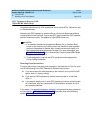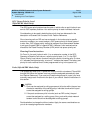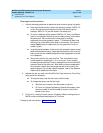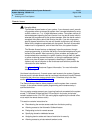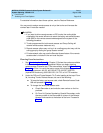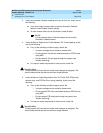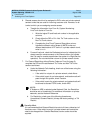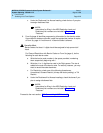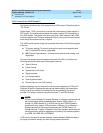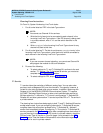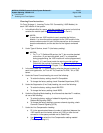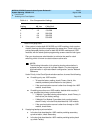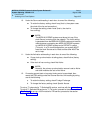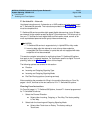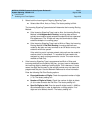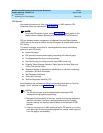
MERLIN LEGENDCommunications System Release 6.1
System Planning
555-661-112
Issue 1
August 1998
Lines/Trunks
Page 3-23Selecting Line/Trunk Options
3
DS1 Connectivity (100D Module) 3
Use these instructions only if the system has a 100D module. Otherwise, skip to
“Tie Trunks.”
Digital Signal 1 (DS1) connectivity involves the transmission of digital signals in
DS1 format. The interface that enables the system to allow DS1 connections is
the 100D module. The system can have up to three 100D modules. Each 100D
module supports up to 24 logical endpoints (IDs) or ports (one for each channel),
even though the module has only one jack.
The 100D module can be configured to operate with either of the following types
of service:
■ T1 (factory setting). To transmit and receive voice and analog data and,
with T1 Switched 56 service, digital data.
■ PRI (Primary Rate Interface). To transmit and receive voice, analog, and
digital data.
To ensure the proper protocol between both ends of the DS1 connection, the
following options should be set for both types of service:
■ Type of Service
■ Frame Format
■ Suppression (Line Code)
■ Signaling mode
■ Line Compensation
■ Clock Synchronization
■ Channel Service Unit (CSU) setting
Additional settings must be entered for both services, especially for PRI and T1
Switched 56 service. Appropriate settings are determined by the transmission
facility to which the module is connected and/or is supplied by the service
provider. This section contains instructions for both T1 and PRI services.
NOTE:NOTE:NOTE:
PRI service for Release 2.0 through Release 4.1 systems requires that the
service provider’s switching equipment be either a 4ESS Generic 13
through 16, 5ESS Generic 6, or a 5ESS serving the FTS2000 (federal
government only) network. PRI service for a Release 1.0 or Release 1.1
system requires that the switching equipment be a 4ESS Generic 13
through Generic 16 switch. Release 4.2 and later systems require that the
service provider’s switching equipment may be any of the above systems,
or a DMS-100, DMS-250, or DEX600E.
If DS1s are to be used for private networks, see the
Network Reference
before
you begin this section and as you work through these instructions.



